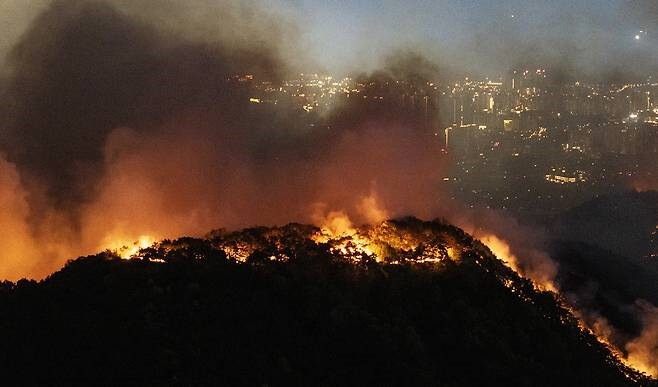
Daegu, South Korea - Barely a day after initial containment, lingering embers on Hamjisan (Hamji Mountain) in Buk-gu, Daegu, flared up and rapidly spread, compelling forestry authorities and related agencies to deploy a significant number of helicopters for suppression efforts. In response to the escalating situation, the National Fire Agency issued a national fire mobilization order, signaling the severity of the renewed outbreak.
The Central Disaster and Safety Countermeasures Headquarters of the Korea Forest Service reported on April 30th that the rekindled fire within the Hamjisan wildfire impact zone necessitated the immediate deployment of 43 helicopters. Additionally, 45 units of firefighting vehicles and other equipment, along with 196 personnel, were dispatched to the scene to combat the spreading flames.
As the fire intensified, the Korea Forest Service elevated the response by issuing a national fire mobilization order at 5:47 PM KST. This directive, invoked when a specific region's firefighting capabilities are deemed insufficient to manage a disaster or when national-level mobilization is deemed necessary, is issued by the Commissioner of the National Fire Agency.
Following the mobilization order, the Gyeongsangbuk-do Fire Department promptly dispatched five pump trucks and five water tankers to the affected area, bolstering the ground-based firefighting capacity.
The resurgence of the fire was concentrated in five locations within the northern and eastern sections of the Hamjisan wildfire impact zone. Initial containment efforts had been underway since approximately 5:37 AM KST on April 30th, with a fleet of 14 helicopters – six from the fire department, five from the forest service, and three chartered by the Daegu Metropolitan City – actively engaged in extinguishing remaining embers.
Throughout the day, persistent firefighting efforts appeared to be successful in suppressing the remaining flames. However, the situation took a turn for the worse in the afternoon as strong winds, with peak gusts reaching 5 to 10 meters per second (approximately 11 to 22 miles per hour), fanned the embers back to life. This resurgence resulted in significant smoke plumes spreading towards the Guam-dong and Seobyeon-dong areas of Buk-gu.
As of the latest reports from forestry authorities, a fire line stretching approximately 2.1 kilometers (around 1.3 miles) had formed, advancing in the direction of Seobyeon-dong. Authorities have indicated that the renewed fire has not yet breached the perimeter of the impact zone established by the initial wildfire.
Despite the approaching nightfall, forestry officials affirmed their commitment to continuing suppression operations. Plans include deploying ground personnel and utilizing thermal imaging drones to monitor the fire's spread and guide firefighting efforts under low-visibility conditions.
In anticipation of further fire spread, the Buk-gu district office issued emergency evacuation alerts to residents in nearby areas.
At approximately 5:13 PM KST, the Buk-gu district office sent out urgent disaster alert text messages to residents, instructing those in the vicinity of Seobyeon-dong to immediately evacuate to designated shelters at Dongbyeon Middle School, Yeongyeong Elementary School, Paldal Elementary School, and Bukbu Elementary School. This proactive measure underscores the authorities' concern about the potential for the fire to encroach on residential areas.
The initial wildfire on Hamjisan erupted at around 2:00 PM KST on April 28th. Over approximately 23 hours, the blaze consumed an estimated 260 hectares (around 642 acres) of forestland, an area equivalent to roughly 364 international-standard football fields (each measuring 7,140 square meters). The main fire was declared extinguished at approximately 1:00 PM KST on April 29th.
However, the respite proved to be short-lived. Approximately six hours after the initial fire was brought under control, at around 7:31 PM KST on April 29th, residual flames reignited on the 70% incline mark towards Baeknyeonsa Temple within Hamjisan. Forestry and fire authorities had been engaged in extinguishing these remaining embers since the early hours of April 30th before the unexpected resurgence occurred.
Hamjisan, a popular hiking destination for Daegu residents, is known for its dense vegetation and rugged terrain, factors that can contribute to the rapid spread and reignition of wildfires. The mountain's proximity to residential areas also elevates the risk and necessitates swift and decisive action from firefighting authorities.
The deployment of a national fire mobilization order highlights the potential severity of the situation and allows for the rapid allocation of resources from across the country. This centralized command structure ensures efficient coordination and deployment of specialized firefighting personnel and equipment, including additional helicopters, ground crews, and specialized vehicles.
The use of a large number of helicopters is crucial in mountainous terrain like Hamjisan, where ground access can be challenging and time-consuming. Helicopters equipped with water buckets or water cannons can deliver significant amounts of water or fire retardant directly onto the flames, playing a vital role in containing the fire's spread and cooling down hotspots.
The challenges faced by firefighters in this situation underscore the unpredictable nature of wildfires, particularly in the presence of fluctuating wind conditions. Even after a fire is seemingly extinguished, hidden embers can persist beneath the surface, capable of reigniting under favorable conditions such as increased wind speed and dry vegetation. This phenomenon necessitates thorough and prolonged monitoring and suppression efforts even after the main fire has been brought under control.
The evacuation order issued by the Buk-gu district office reflects the authorities' commitment to prioritizing the safety of residents living near the affected areas. Prompt evacuation can significantly reduce the risk of casualties and property damage in the event of rapid fire spread towards residential zones. The designated shelters provide temporary refuge and essential support for those displaced by the potential threat.
The incident on Hamjisan serves as a stark reminder of the ongoing wildfire season in South Korea and the potential for significant damage to natural environments and communities. It also highlights the critical role of rapid response, inter-agency coordination, and proactive measures such as evacuation orders in mitigating the impact of such events.
Authorities are expected to provide further updates on the progress of the firefighting efforts and the extent of the damage as the situation unfolds. The focus remains on fully extinguishing the resurgent flames, ensuring the safety of residents, and preventing further spread of the fire beyond the existing impact zone. The national fire mobilization order will likely remain in effect until the situation is fully under control and the risk of further reignition is minimized. The aftermath of this event will undoubtedly involve a thorough assessment of the causes of the initial fire and the subsequent reignition, as well as the implementation of measures to prevent similar incidents in the future. The resilience of the Daegu community and the dedication of the firefighting personnel will be crucial in navigating the challenges posed by this latest wildfire incident on Hamjisan.
[Copyright (c) Global Economic Times. All Rights Reserved.]



























